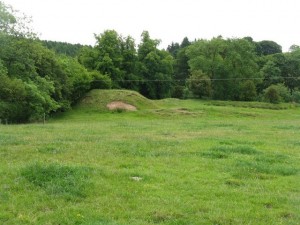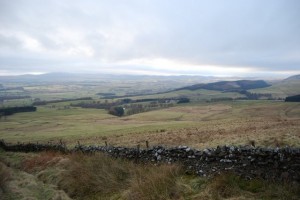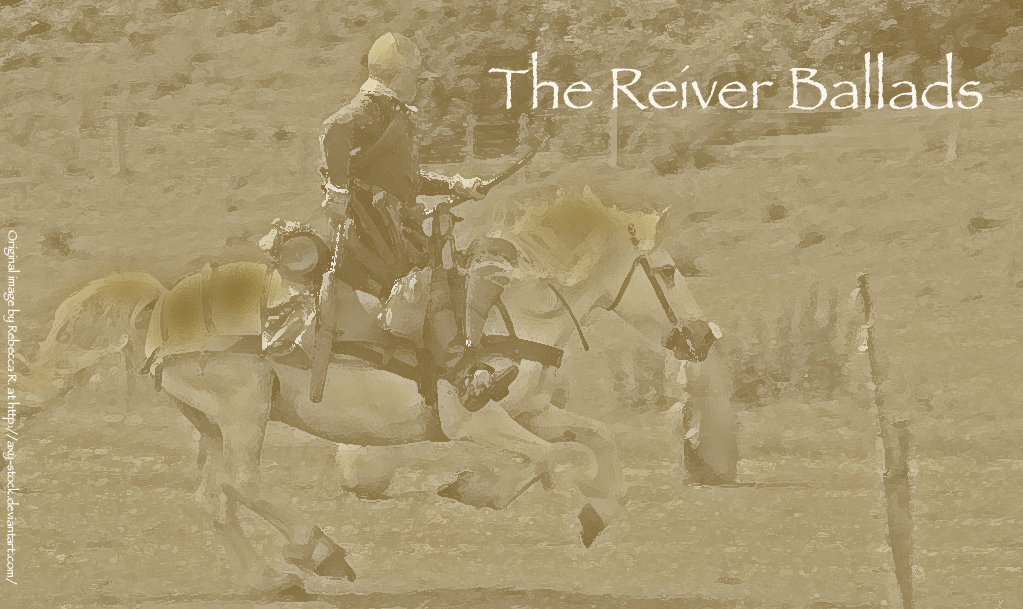The Lads of Wamphray
This ballad had not been published prior to its inclusion in the first edition of the Minstrelsy of the Scottish Border in 1802, where it appears in the first volume. Scott derived his version from that in Glenriddell MS. He omitted the introductory subscription to the ballad which appears in Glenriddell: “Lads of Wamphray Ane Old Ballad sometimes called the Galiard” (GL: 34), but does refer to this to-name in the notes preceding the ballad. Scott omitted two verses of the Glenriddell version (verses 4 and 36), transposed two line groupings and inserted four lines after the line “The Diel’s in them for pride and greed”.
This ballad follows “Lord Maxwell’s Goodnight”, in the editions of the Minstrelsy, as both are connected to the long-standing Johnstone-Maxwell feud. However, the events associated to the action in “The Lads of Wamphray” pre-date those commemorated in “Lord Maxwell’s Goodnight”.
History
The Johnstone family were one of the dominant families living in what became the Scottish West March, with Annandale being their main haunt. Their power-base was consolidates by their support of King James II against the Douglas family in the mid fifteenth century. At that time the Black Douglases controlled almost all of the South West of Scotland and posed a serious threat to the Stewart monarchy. The Black Douglases were defeated by the King’s forces – including the Johnstones – at Arkinholm, near Langholm and submitted to the King’s seige at Threave Castle. The Douglas lands were attained by the King, and much of them were given over to those familes who had supported his campaign against the Douglases.
By the 16th century, however, the Johnstones were listed as one of the more troublesome Border families and had begun their long feud with the Maxwells (see “Lord Maxwell’s Goodnight”).
There is no concrete history connecting the “The Lads o’ Wamphray” with any specific incident. However, the ballad narrative tells of an abortive horse theft, which results in the death of “The Galliard” and a revenge raid led by his nephew, Willie of Kirkhill. Several books, which mention this event, seem to use the ballad, in part, as evidence of the event.
There are several historical incidents which have become associated with this ballad, one being a postscript in a letter from Sir John Carmichael, the Scottish West March Warden to Lowther, his English counterpart, dated 10th July 1592. The letter itself is interesting in that it was most probably one of the last Carmichael wrote while in office at that time. The postscript reads:
Willie Johnestoun of Kirkhill hes ane blak hors of my cousing Wille Carmychel of Reidmyre. It will ples your lordschip to cawse delyver him to the Lard of Gretnay (CBP II: 400).
It was not long, however, before the Johnstones were riding once more, and Spottiswood noted that they “made a great depredation upon the lands of Sanquhar and Drumlanrig, and killed eighteen persons that followed for rescue of their goods” (Spottiswoode (1851) ii: 445). The Historie and Life of King James the Sext contains more details about the same incident:
During the whilk tyme, be the industrie of certayne peceable wyse gentilmen of the Johnestons, sic incredible peax was concludit amang thayme [Lord Maxwell and the Laird of Johnstone], evin besyde all menis expectatioun … and this continewit, and wald appeirantlie have bene langer, geve sum unbrydlit men of Johnstons had not hapnit to ryd a steiling in the moneth of Julij rus present yeir of God 1593, in the lands and territoreis pertening to the Lord Sanquhar and the knychtis of Drumlanryg, Lag and Closeburne, upon the water of Nyth; whare attoure the great reif and spulyé that thay tuik away with violent hand, thay slew and mutilat a great nomber of men, wha stude for defence of thair awin geir and to reskew the same from the hands of sik vicious revers (The Historie and Life of King James the Sext (1825): 297)
Both The Book of Carlaverock and the Annandale Family Book make reference to Spottiswoode’s remarks, and they both ascribe this incident as the source for Scott’s “The Lads of Wamphray”.
The repercussions of this raid were dramatic, as reported in the Annandale Family Book and also in Calderwood: the injured parties seemed to be for the most part Crichtons. According to the Annandale Family Book, they appealed to Lord Maxwell, the recently appointed Warden of the West March, and also to the king and the privy council, but to no avail. When this approach failed, another, more graphic complaint was made:
Upon the same day, after noone, the 22d of Julie, there came certane poore weomen out of the south countrie, with fyftene bloodie shirts, to compleane to the king that their husbands, sonnes, and servants, were cruellie murthered in their owne houses by the Lard of Johnstoun, themselves spoiled, and nothing left them. The poore weomen, seing they could not gett satisfactioun, casued the bloodie shirts to be caried by pyoners through the toun of Edinburgh, upon Moonday, the 23d of Julie. (Calderwood (1844) v: 256)
The Characters
The Lads of Wamphray
 In on the 25th October 1569 the then Laird of Johnstone stood as security for John Johnstone of Howgill, who was taken as a pledge “for all that ar cum of the auld gang of Wamfray” (Annandale Family Book: lxvii, Register of the Privy Council (1st series) ii: 52)) and also promised to bring before the regent in Dumfries “the principallis of the gang of Willeis of Wamfra” (RPC 1st series ii 47-50). In 1581, Thomas Johnstoun of Fingland stood security for the Wamphray Johnstones (The History of the Johnstones: 98). It is clear, then, that the events of the ballad, which have been associated with the Wamphray Johnstones, would not be out of character.
In on the 25th October 1569 the then Laird of Johnstone stood as security for John Johnstone of Howgill, who was taken as a pledge “for all that ar cum of the auld gang of Wamfray” (Annandale Family Book: lxvii, Register of the Privy Council (1st series) ii: 52)) and also promised to bring before the regent in Dumfries “the principallis of the gang of Willeis of Wamfra” (RPC 1st series ii 47-50). In 1581, Thomas Johnstoun of Fingland stood security for the Wamphray Johnstones (The History of the Johnstones: 98). It is clear, then, that the events of the ballad, which have been associated with the Wamphray Johnstones, would not be out of character.
Antipathy between the Crichtons and the Johnstones seems to have been a part of life in the West Marches, as Henry Leigh, deputy warden of the English West March noted:
I stayd at Collington, the rather because the tyme was troblesom for the Layrd Johnston had layne in wayt for the Lord Sancquar and had chased him twyse on one day, and Sim of Puddinge burne was abroad with his gward of theeves, to rob the passengers to the fayre, and I was loath to fall in such handes. (Depostion of Henry Leigh, April 12th, 1600 CBP II: 648)
Johnstone of Wamphray ‘The Galliard”
 There are several individuals, who have been recorded with this to-name. However, there are no extant sources to link the name to the then leader of the Wamphray Johnstone, with most of the information being provided by Johnstone biographers. The name William is favoured by the Johnstones in the 1500s (as is James), which makes for complications in identifying individuals.The Johnstones had the lands of Wamphray in their possession from 1476 (Annandale Family Book: cccxli). The History of the Johnstones indicates that The Galliard was a brother to the Gilbert Johnstone, Laird of Wamphray (and was also known as William of Kirkhill), and the author states that this William Johnstone was killed by the Crichtons in 1592. He reiterates this in the genealogical tables towards the back of the book. There does, however, seem to be some assumptions made in them, which are not based on documentary evidence.
There are several individuals, who have been recorded with this to-name. However, there are no extant sources to link the name to the then leader of the Wamphray Johnstone, with most of the information being provided by Johnstone biographers. The name William is favoured by the Johnstones in the 1500s (as is James), which makes for complications in identifying individuals.The Johnstones had the lands of Wamphray in their possession from 1476 (Annandale Family Book: cccxli). The History of the Johnstones indicates that The Galliard was a brother to the Gilbert Johnstone, Laird of Wamphray (and was also known as William of Kirkhill), and the author states that this William Johnstone was killed by the Crichtons in 1592. He reiterates this in the genealogical tables towards the back of the book. There does, however, seem to be some assumptions made in them, which are not based on documentary evidence.
Some evidence for Johnstone of Wamphray also being known as Kirkhill; in a document of 1581, when “Geordie Johnstoun (lay) parson of Corrie, is a cautioner with this chief for William Johnstoun of Kirkhill and Wamfray” (The History of the Johnstones: 96). There is another William in the next generation, who may well have suggested the uncle-son relation presented in the ballad, and the ballad may have compressed two separate incidents into the one event.
Willie of Kirkhill
William Johnstone of Kirkhill is recorded in the Calendar of Border Papers, as being the thief of the black horse belonging to Sir John Carmichael’s cousin, William Carmichael of Reidmyre, the theft of which was the first act in the final years of the Johnstone-Maxwell feud. Anecdotal history offers William Johnstone of Kirkhill the killing blow on Lord Maxwell at the Battle of Dryffe Sands. However, there are other versions of Maxwell’s death.
Sim Crichton
The Laird of Sanquhar was a title belonging to the Crichtons. However, the first name of the Laird at the time was not Simon, but Robert. The History of the Johnstones indicates that it was the Laird who lost a horse at the hands of Will of Kirkhill and his uncle, as recompense for the black horse he had been forced to return, but this may have been suggested by the ballad. The citations referring to Simon Crichton post date the publication of the ballad, and seem to use the ballad as a reference point. However, the place of the battle is names as Simon's Knowe, so there may be some historical fact in ascribing the name to the wronged character in the ballad.
___________________________
Leithen Hall image:
© Copyright M J Richardson and licensed for reuse under this Creative Commons Licence
Wamphray Glen image:
© Copyright Thomas Dick and licensed for reuse under this Creative Commons Licence
